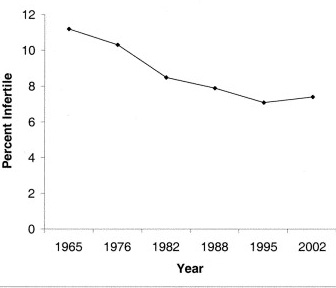Infertility and spontaneous abortion
Declining estimates of infertility in the United States: 1982-2002
OBJECTIVE: To determine if the decline in infertility has been uniform across subgroups.
DESIGN: Periodic data from the National Fertility Survey and the National Survey of Family Growth were used to determine which factors contributed to the decline in 12-month infertility in the United States. A woman is classified as “infertile” if she has not conceived a pregnancy after ≥12 months of unprotected intercourse with her husband or cohabiting partner.
SETTING: National Survey of Family Growth, a periodic US nationally representative study.
PATIENT(S): A nationally representative sample of married women aged 15-44 years, N = 15,303 for pooled data across 4 survey years.
MAIN OUTCOME MEASURE(S): Estimates of infertility prevalence among married women aged 15-44 years.
RESULT(S): The decline in 12-month infertility in the United States from 8.5% in 1982 and 7.4% in 2002 was significant. This decline was evident in nearly all subgroups of married women. In the multivariate analysis, 12-month infertility was more likely among women who were older and nulliparous, were non-Hispanic black or Hispanic, and did not have a college degree. The decline in 12-month infertility was observed even after controlling for the compositional differences of the population over time.
CONCLUSION(S): Among married women in the United States, there has been a significant decline in 12-month infertility, which cannot be explained by changes in the composition of the population from 1982-2002.

Trends in 12-month infertility among married women aged 15–44 years, 1965–2002.